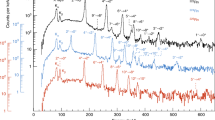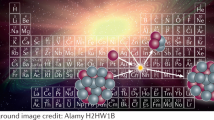Abstract
ONE of the most exciting hypotheses put forward to explain the molecular asymmetry of living beings is based on a physical concept, the ‘parity nonconservation law’1. According to this, matter is intrinsically asymmetric (β particles are always spin polarised) and the molecular asymmetry on Earth is a reflection of the structure of matter itself2–5. Though the theory is attractive, experimental results are controversial. Some people have reported differences in the radiation susceptibility of the two enantiomers (D and L forms) of a molecule if irradiated with β− particles and/or their associated circularly polarised γ rays (bremsstrahlung)6, whereas others have failed to detect any differential radiolysis in similar experiments7. One possible explanation for the controversial data may be that the decomposition of molecules depends on many factors which may mask the expected differential interaction between β− particles and optical isomers. To avoid these disturbing factors, we studied the annihilation of β+ particles in optical isomers, exploiting the great advantage of this technique that it gives information about the interaction process itself rather than about the products of interaction.
This is a preview of subscription content, access via your institution
Access options
Subscribe to this journal
Receive 51 print issues and online access
$199.00 per year
only $3.90 per issue
Buy this article
- Purchase on Springer Link
- Instant access to full article PDF
Prices may be subject to local taxes which are calculated during checkout
Similar content being viewed by others
References
Lee, T. D., and Yang, C. N., Phys. Rev., 104, 254 (1956).
Vester, F., Ulbricht, T. L. V., and Krauch, H., Naturwissenschaft, 46, 68 (1959).
Ulbricht, T. L. V., Q. Revs, 18, 48 (1959).
Ulbricht, T. L. V., and Vester, F., Tetrahedron, 18, 629 (1962).
Vester, F. thesis, Univ. Saarlandes, Saarbrücken (1963).
Garay, A. S., Nature, 219, 338 (1968).
Bernstein, W. J., Lemmon, R. M., and Calvin, M., Molecular evolution (edit. by Rohlfing, D. L., and Oparin, A. I.), 151 (Plenum, New York, 1972).
Goldanskii, V. I., Positron annihilation (edit. by Stewart, A.T., and Roelling, L. O.), 183 (Academic Press, New York, 1967).
Wald, G., Ann. N. Y. Acad. Sci., 69, 352 (1957).
Seelig, F. F., J. theor. Biol., 31, 355 (1971).
Ageno, M., J. theor. Biol., 37, 187 (1972).
Decker, P., Nature new Biol., 241, 72 (1973).
Landau, L. D., and Lifshitz, E. M., Theoretical Physics, 8, 313 (Pergamon, Oxford, 1960).
Author information
Authors and Affiliations
Rights and permissions
About this article
Cite this article
GARAY, A., KESZTHELYI, L., DEMETER, I. et al. Origin of asymmetry in biomolecules. Nature 250, 332–333 (1974). https://doi.org/10.1038/250332a0
Received:
Revised:
Issue Date:
DOI: https://doi.org/10.1038/250332a0
This article is cited by
-
The origin and amplification of biomolecular chirality
Origins of life and evolution of the biosphere (1991)
-
Beta-gamma decay and stereoselective molecular breaking
Journal of Molecular Evolution (1987)
-
Investigation on the chirality of positrons from22Na decay and their asymmetrical interactions with D-, L- and DL-alanines
Il Nuovo Cimento D (1987)
-
β Decay and the origins of biological chirality: experimental results
Nature (1982)
-
Asymmetrical radical formation in D- and L-alanines irradiated with tritium-?-rays
Origins of Life (1982)
Comments
By submitting a comment you agree to abide by our Terms and Community Guidelines. If you find something abusive or that does not comply with our terms or guidelines please flag it as inappropriate.



